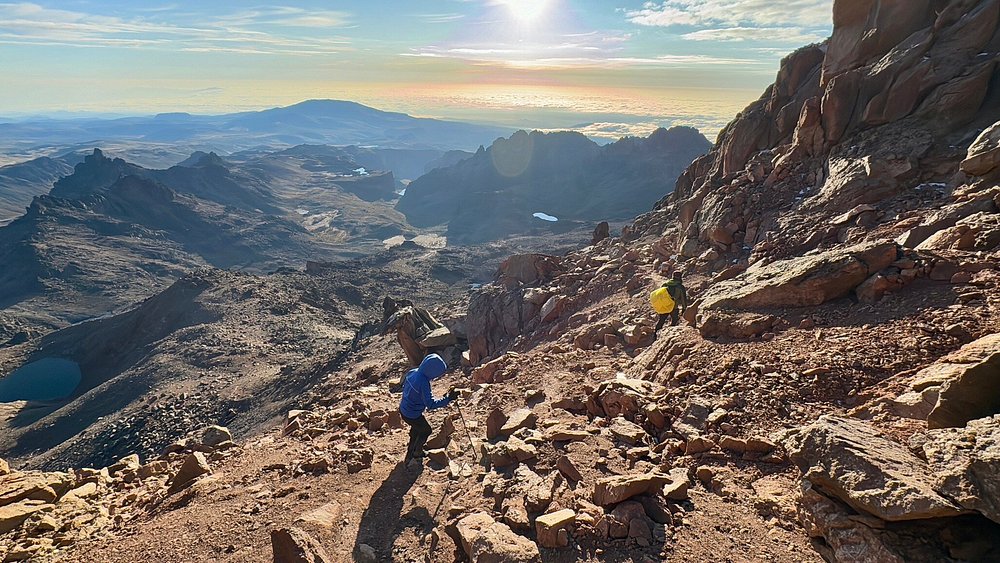
Ultimate Guide to Trekking Mount Kenya | All You Need to Know
Originally known as “Kirinyaga,” meaning “mountain of whiteness,” Mount Kenya has silently called on hikers to touch its snowcapped peaks. Thousands of hikers worldwide journey to central Kenya each year to trek Mount Kenya. Its varied trekking routes, multiple peaks, and amazing scenery make trekking Mount Kenya a treat for all.
This multi-peaked mountain is generous to climbers of all levels, from beginners to veteran mountaineers. Nature lovers, social climbers, adventurers, and professionals are sure to find something to love in its mosaic of natural features and multifaceted geography.
In this piece, you’ll learn everything you need to know about hiking Mount Kenya to the summit.
But first, let’s learn a little bit more…
About Mount Kenya
Mt Kenya is the second-highest mountain in Africa after Mount Kilimanjaro in Tanzania. The mountain is an extinct volcano that last erupted around 2.6 million years ago. Although no one can be sure of its last eruption, the lack of notable precursors like increased seismic activity proves the mountain is inactive.
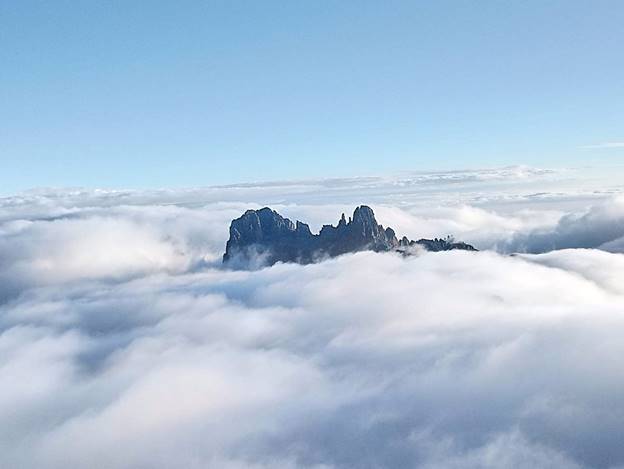
In 1949, the mountain was turned into a protected area and named Mount Kenya National Park. The park houses over 800 documented plant species with 81 of them being endemic to Mount Kenya. Hikers can spot various wildlife species in the park, like elephants, zebras, hyenas, and buffalo, just to name a few. You might spot a leopard, rhino, or the elusive giant forest hog on your Mount Kenya trek if you're lucky. Due to the mountain’s richness in flora and fauna, impressive landscape, and ecological importance, Mount Kenya was labelled a UNESCO World Heritage Site in 1997.
Although Mount Kenya is a protected area, it still faces some conservation problems. One of the major ones is the gradual loss of its glaciers due to climate change. If things continue as they are, Mount Kenya’s 12 glaciers are estimated to disappear by 2030, and so will the meaning of its original name.
How to Climb Mount Kenya
Hiking Mount Kenya is best done through the help of professional guides and porters. Guides are trained to safely lead people on mountain climbing expeditions and ensure they have the best time. Porters, conversely, help climbers have an easier time hiking Mount Kenya by providing them with food, water, and shelter. Apart from supporting climbers mentally and physically, these professionals also provide medical assistance in case of health issues like altitude sickness.
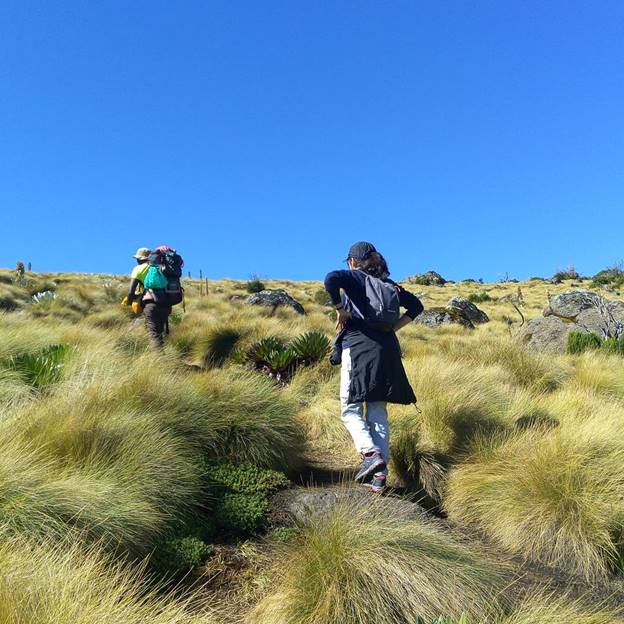
The help of professional guides and porters is important if you want to drastically increase your chances of summiting Mount Kenya. Typically, the tour company you choose to climb with will provide guides and porters for your trip.
Remember, while it’s possible to hike Mount Kenya unassisted, it is not recommended unless you’re a highly experienced mountain climber.
How Hard Is It to Climb Mount Kenya?
The difficulty of trekking Mount Kenya will mostly depend on your chosen route and peak. Most people agree that the Sirimon route is the easiest, while the Chogoria route is the hardest but also the most scenic. However, good guidance, adequate training, and proper equipment are essential, regardless of your chosen hiking route.
As a Grade VI Mountain at its two tallest peaks, Mount Kenya is fairly difficult to climb. Mountains of Grade V and higher require hikers to have at least one overnight stay for a successful hike. Therefore, climbing Mount Kenya requires you to set aside a few days to complete the expedition, especially if you’re a beginner.
- Beginners
Sirimon route is best for beginners because it offers more gentle slopes than steep ones. This route is also incredibly scenic and offers great camping spots. If you’re looking for more challenge while hiking Mount Kenya, you can ascend via the Sirimon and descend via the Chogoria route.
- Experienced hikers
The best routes for experienced climbers are the Chogoria, Naro Moru, and Burguret routes. These two routes cut through rugged terrains with steep slopes and rocky paths. Experienced climbers looking for a more interesting hike can also choose the Burguret route. This route goes through dense vegetation and offers a more challenging trek.
- Technical climbers
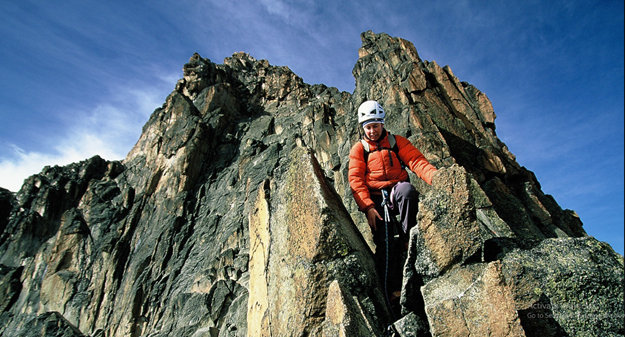
For those seeking to reach the absolute summit of Mount Kenya, the Mackinder's route is the path to trek. Mount Kenya technical climbing involves difficult rock and ice scaling that requires experience and special equipment.
How Long Does It Take to Climb Mount Kenya?
How long it takes to hike Mount Kenya depends largely on your chosen route and your hiking experience. Beginners can take four to seven days, while experienced climbers can trek it in as little as three days.
The average time needed to climb Mt Kenya successfully is four to five days. For the average person, any expedition that is less than four days, say three or two, is unsafe. We recommend a five-day Mount Kenya tour package for first-time mountain climbers and a four-day tour package for experienced climbers.
Naturally, the longer you spend trekking Mount Kenya, the more time you’ll have to enjoy the trip. A longer hike duration also gives you enough time to acclimate, making the trip much easier and more enjoyable.
Acclimatising to Mount Kenya
Regardless of the route you choose, the climbing equipment you have, or your hiking experience, altitude sickness can prevent you from conquering Mount Kenya. Acclimatisation helps you gradually adapt to the high-altitude climate of mountains. And since Mount Kenya’s third-highest peak, Pt Lenana, is higher than some Himalayan peaks, proper acclimatisation is crucial to successfully hiking Mount Kenya.
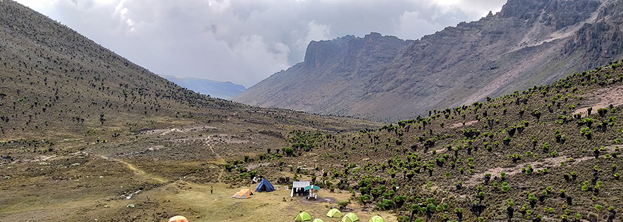
Professional Mount Kenya guides are trained to help climbers properly adapt to the high altitude using some effective acclimatization strategies. These strategies include –
- Gradual ascent
- Overnight stay at high-altitude camps
- Following the golden rule of ‘climb high and sleep low’
- Proper hydration and nutrition
- Adequate sleep
- Acclimatization days – light Mount Kenya trekking for half a day
Helpful as they are, guides can only do so much to help you acclimatize. If you find yourself struggling with altitude sickness, let your guide know, and they’ll take the necessary steps. You can avoid altitude sickness when climbing Mount Kenya by doing the following;
- Proper training before embarking on your trek
- Maintaining a steady pace when hiking
- Listening to your body
- Staying positive
- Avoiding/reducing alcohol consumption, smoking, and vaping during the climb
What Equipment Do I Need to Trek Mount Kenya?
Proper equipment is essential in climbing Mount Kenya or any other mountain. While finding and buying the required equipment can seem like a hassle, it is much easier in reality. Most tour companies will guide you on what you need, including the make and model of the equipment. You’ll also find that most mountain climbing equipment are lightweight and practical.
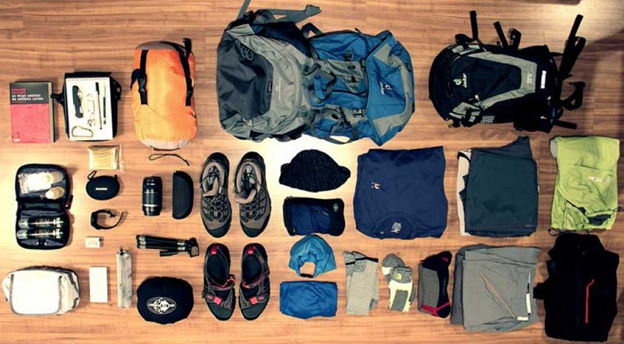
Here are some of the most common equipment needed to climb Mt Kenya -
- Hiking boots
- Gaiters
- Waterproof layer of clothing
- Gloves and sunhat
- Trekking poles
- Water bottle and vacuum flask
- Personal amenities and toiletries
- Sleeping bag
- Hiking bag
- A pair of sunglasses
You can refer to this piece for an exhaustive list of climbing essentials. If you’re unsure of what to bring along, kindly ask your tour operator.
Once you have all your equipment ready, standing at the foot of the mountain, porters will help you carry most of your luggage. You will only be left with what is needed for trekking Mount Kenya.
Remember, there is a weight limit on what you can bring on your Mount Kenya trek, and porters will carry up to 10kg (22lbs) of your luggage. However, you can exceed this limit by hiring an additional porter but this will cost you extra.
Mount Kenya Hiking Routes | Which Route Should You Choose?
Overall, there are five Mount Kenya climbing routes from which you can choose. Each route is distinct enough from the next to offer a unique hiking experience. As a result, it is recommended that you select a route package that offers different ascending and descending routes. For example, you can choose to ascend via Chogoria and descend via Naro Moru.
Climbing Mount Kenya with one route for the entirety of the hike is also acceptable and has its perks. This strategy allows you to experience everything a route has to offer.
Chogoria Route
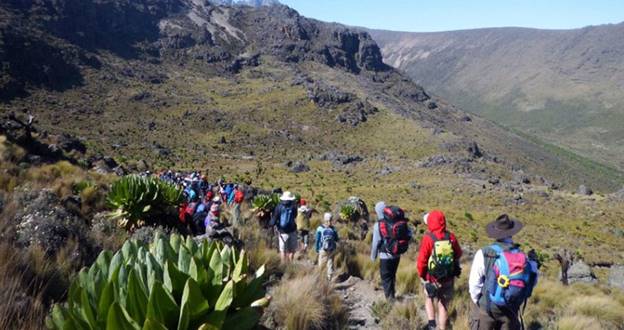
The Mount Kenya Chogoria route is one of the three main Mt Kenya climbing routes that does not require technical climbing skills. Together with the Naro Moru and Sirimon routes, it is the most popular route.
This route passes through some of Mount Kenya’s most notable sites, like the Nithi Gorges, Lewis Glaciers, and the “Temple”. When it comes to scenery, the Chogoria route is a close second after Sirimon, but many argue it tops all other routes. Chogoria also offers great camping spots at distinct locations like the Mintos Hut. Additionally, you’ll pass by several lakes and streams through this route. The most famous lake on this route is Lake Michaelson at 3,500m, where you can camp and picnic on its scenic shores.
All in all, the Chogoria route is a great route for both first-time and experienced hikers climbing Mount Kenya. The route isn’t too long, and neither is it too easy; it offers a perfect balance in terms of beauty and difficulty.
Sirimon Route
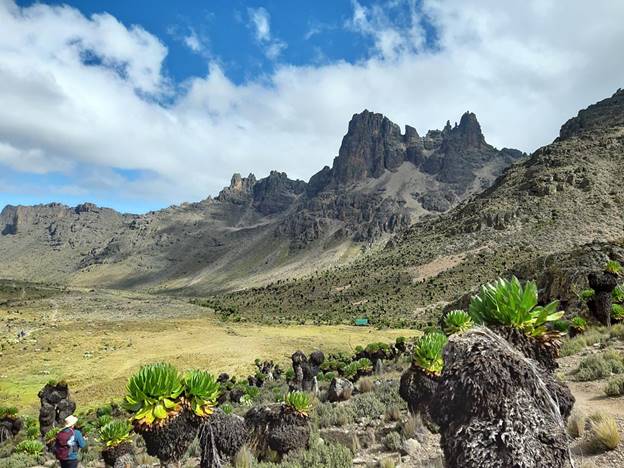
The Mount Kenya Sirimon Route is arguably the most popular route to trek Mt Kenya. This route approaches the mountain from the North and thus offers great views of the three main peaks. Apart from the scenery, the Sirimon route is also the easiest route for trekking Mount Kenya. It offers a gradual climb with not so many steep slopes and is also drier than all other routes. Since the route approaches the mountain from the leeward side, it receives less rain than other routes all year long.
Many label the Sirimon route as the most scenic route due to its abundance of spectacular views and notable sites. These include;
- Gorges and Mackinder valleys
- Views of Nelion and Batian peaks
- Heathers, bamboo, rocky ridges, and glaciers
- Ontulili and Liki North rivers
- Permanent camps (Old Moses and Shipton’s camps)
The best way to experience this route is with a Mount Kenya Sirimon Chogoria route package. First-time hikers can climb Mount Kenya via Sirimon and descend via Chogoria while experienced hikers can ascend via Chogoria and descend via Sirimon. This route package gives you a holistic Mt Kenya hiking experience.
Naro Moru Route
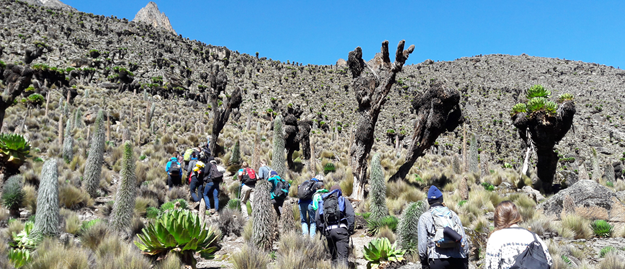
The Naro Moru route Mount Kenya is the shortest route to the summit. It used to be the most popular route but was overtaken by Sirimon and Chogoria. Still, it remains a great route that offers unique views and experiences.
The route offers amazing accommodation and amenities at higher altitudes which makes the hike more enjoyable. At the Met Station cabins (3,050m) you will find dormitory-style accommodation, wi-fi, solar energy, a snack shop, and dining tables. As you continue trekking Mount Kenya, you will find the Austrian Hut close to Pt Lenana. These campsites act as oases on the route since Naro Moru cuts through sections of dense vegetation and is close to the windward side of the mountain.
Hiking Mount Kenya through this route gives you a greater chance of seeing wildlife than on Sirimon or Chogoria. You may see bushbucks, elephants, colobus monkeys, waterbucks, and tree hyrax, just to name a few. Additionally, Naro Moru offers great views of the Vertical Bog, Teleki Valley, and the peaks.
You can combine this route with either Sirimon to experience different sides and climates of Mount Kenya.
Burguret Route
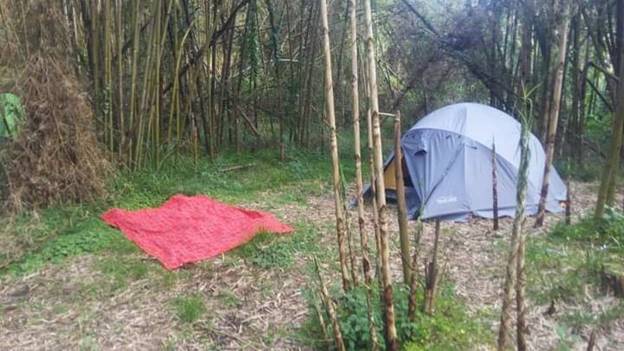
The Burguret Route is one of the three lesser-known Mount Kenya climbing routes. This route approaches the mountain from the West and is one of the most difficult routes. The path isn’t clear, especially on the lower grounds. As you start trekking through Burguret, you’ll need to do some ‘path clearing’ and ‘route finding’. This makes for a very interesting hiking experience through the jungle. However, once you clear the lower ground, the route opens up as you head into the heath and moorlands.
There are no huts or permanent campsites on this route, which, coupled with its difficulty, makes it less used. This makes it a great option for those looking for a less crowded route to climb Mount Kenya. This route is best suited for experienced climbers. Still, first-time hikers can trek it given enough time (6 days or more).
Kamweti Route
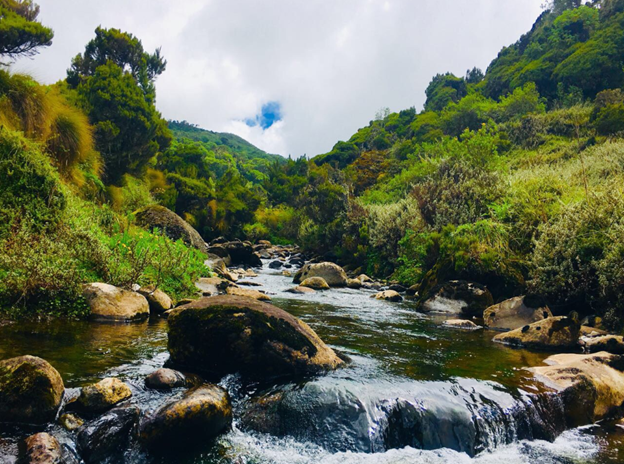
Similar to the Burguret route, the Kamweti route requires one to do some ‘pathfinding’. The route welcomes you with a dense rainforest filled with chirping birds, streams, and ancient bridges that make you feel like an old-time explorer. As you continue climbing Mount Kenya through the Kamweti route, you’ll pass through some amazing sites like Ford Falls, bamboo forest, Thegu and Teleki valleys, Lewis Glaciers, and Lake Howell.
This route is best suited for those looking for a road less traveled that is beautiful yet not too challenging.
Timau Route
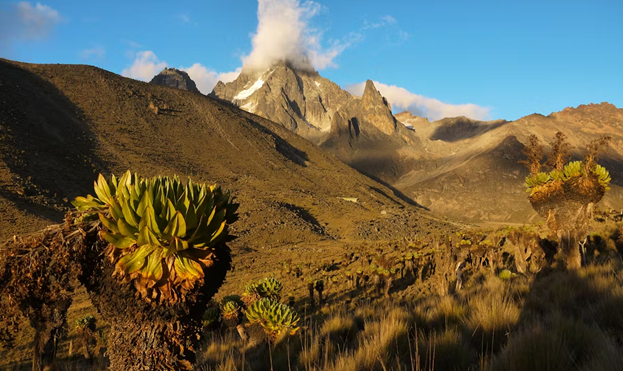
The Mount Kenya Timau route approaches the mountain from the North and is the main access route on the Northern side. This route is mainly used by technical climbers seeking to scale Batian and Nelion. Surprisingly, the Timau route is gentler and more open than Kamweti and Burguret. This makes it a great alternative for hikers looking for a more challenging hiking adventure.
First-time hikers can use this route to climb Mount Kenya then switch to the Chogoria route at Hall Tarns.
Note* Conditions on this route can vary according to seasons and advice from Kenya Wildlife Service (KWS) Rangers is needed before climbing Mount Kenya via Timau route.
Best Time of Year to Climb Mount Kenya
The best time of the year to trek Mount Kenya is between late December to early March and June to October. These two periods of time are the warmest and driest seasons in Central Kenya and Kenya as a whole to some extent. Ultimately, the absolute best season to climb Mount Kenya is during the dry season; from late June to October. This season is characterized by clear skies, high chances of viewing wildlife, night sky stargazing, and high success rates.
November to December is the season of short rains when the weather is unpredictable. During this season, although rains are only occasionally heavy, they usually fall in the afternoon and for a short period. If you’re planning on climbing during this season, it is best to choose routes on the leeward. Sirimon and Naro Moru are great options during this season.
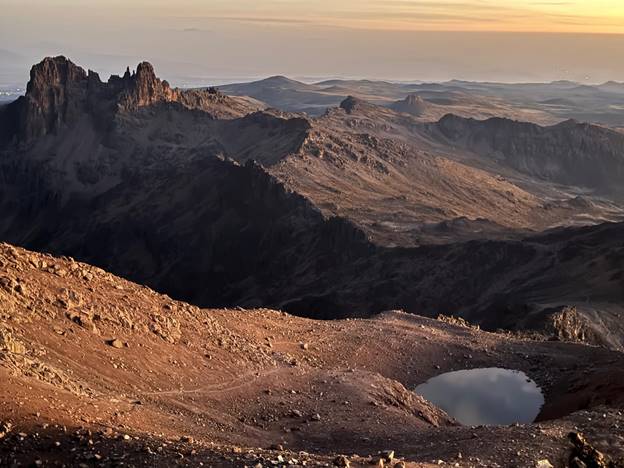
Still, it is essential to note that climbing Mount Kenya is possible throughout the year. Even during the long rainy season, it is incredibly rare to experience bad weather for the entirety of your trip.
Final Words
Trekking Mount Kenya is a unique experience that lasts a lifetime. The mountain has something for everyone, from the surrounding communities and Kenya as a whole to hikers, safari enthusiasts, and lovers of adventure. Should you get the chance to climb Mount Kenya, we only ask you to treat it with respect.
See you at the top!
Samuel Kanuna
Mt. Kenya Trekking Expert